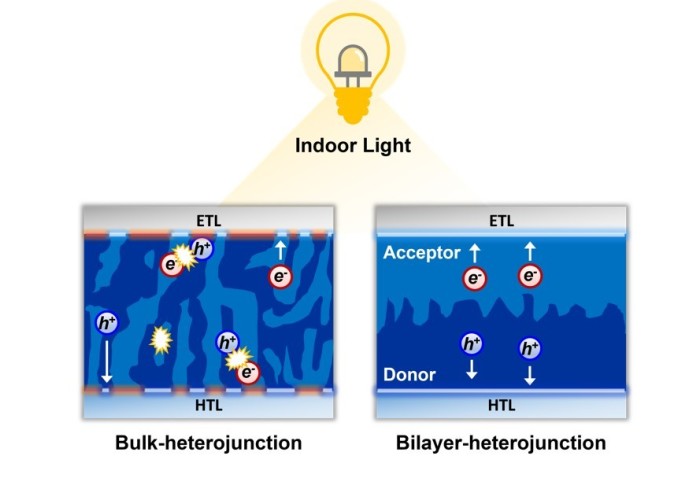Solar cells could recycle indoor light to generate electricity
by Lisa Bushby

Organic bilayer photovoltaics could recycle indoor light to generate energy-efficient electricity
Wireless electronic communication devices have attracted a great attention recently, such as Internet of Things (IoT), radio-frequency identification (RFID), Bluetooth low energy (BLE), etc. Due to development of technology, many of wireless electronic devices can well perform with only a few micro- to milli-watts of power. For smooth communications between those devices, a continuous power source is needed.
One such potential power sources that could be utilised is continuous indoor light. One way to recycle indoor light to generate electricity is through the use of solar cells (also called photovoltaics) which can convert not only sunlight but also any kind of light sources to electricity. Most high-efficiency solar cells are aimed at using sunlight, not indoor light. Therefore, such solar cells may not be optimum for use of indoor light, because sunlight and indoor light have different emission spectra and light intensity. Organic photovoltaic devices are known as a good candidate for indoor light harvesting, due to their excellent light absorbing ability and that they are spectrally well-matched with indoor light.
Researchers at Imperial College London have demonstrated efficient indoor light harvesting using organic photovoltaic devices with a particular structure of photoactive layer, a so called “bilayer-heterojunction”. Bilayer photovoltaic devices show much higher maximum power output for particularly indoor light conditions, compared to commonly used bulk-heterojunction devices. The team attributes the improved performance of the bilayer devices to ideal donor and acceptor distribution which leads to suppression of trap-assisted recombination. Through this study, they suggest that not only by selecting proper organic photoactive materials, the device structure should be considered as an important element to achieve high efficiency for indoor photovoltaic application.
‘Organic Bilayer Photovoltaics for Efficient Indoor Light Harvesting’ by Song Yi Park, Chiara Labanti, Joel Luke, Yi-Chun Chin and Ji-Seon Kim is published in Advanced Energy Materials.
Publication link - https://doi.org/10.1002/aenm.202103237
Article text (excluding photos or graphics) © Imperial College London.
Photos and graphics subject to third party copyright used with permission or © Imperial College London.
Reporter
Lisa Bushby
Department of Physics